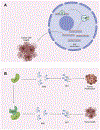Systematic Review of Epigenetic Therapies for Treatment of IDH-mutant Glioma
- PMID: 35314408
- PMCID: PMC9177782
- DOI: 10.1016/j.wneu.2022.03.051
Systematic Review of Epigenetic Therapies for Treatment of IDH-mutant Glioma
Abstract
Background: Isocitrate dehydrogenase (IDH) mutations are present in 70% of World Health Organization grade II and III gliomas. IDH mutation induces accumulation of the oncometabolite 2-hydroxyglutarate. Therefore, therapies targeting reversal of epigenetic dysregulation in gliomas have been suggested. However, the utility of epigenetic treatments in gliomas remains unclear. Here, we present the first clinical systematic review of epigenetic therapies in treatment of IDH-mutant gliomas and highlight their safety and efficacy.
Methods: We conducted a systematic search of electronic databases from 2000 to January 2021 following PRISMA guidelines. Articles were screened to include clinical usage of epigenetic therapies in case reports, prospective case series, or clinical trials. Primary and secondary outcomes included safety/tolerability of epigenetic therapies and progression-free survival/overall survival, respectively.
Results: A total of 133 patients across 8 clinical studies were included in our analysis. IDH inhibitors appear to have the best safety profile, with an overall grade 3/grade 4 adverse event rate of 9%. Response rates to IDH-mutant inhibitors were highest in nonenhancing gliomas (stable disease achieved in 55% of patients). In contrast, histone deacetylase inhibitors demonstrate a lower safety profile with single-study adverse events as high as 28%.
Conclusion: IDH inhibitors appear promising given their benign toxicity profile and ease of monitoring. Histone deacetylase inhibitors appear to have a narrow therapeutic index, as lower concentrations do not appear effective, while increased doses can produce severe immunosuppressive effects. Preliminary data suggest that epigenetic therapies are generally well tolerated and may control disease in certain patient groups, such as those with nonenhancing lesions.
Keywords: Epigenetics; Glioblastoma; Glioma; HDAC; Histone deacetylase inhibitor; IDH.
Copyright © 2022 Elsevier Inc. All rights reserved.
Conflict of interest statement
Conflicts of interest statement: MID is a member of the advisory board of Agios and Forma Therapeutics.
Figures




Similar articles
-
The IDH paradox: Meta-analysis of alkylating chemotherapy in IDH-wild type and -mutant lower grade gliomas.Neuro Oncol. 2024 Oct 3;26(10):1839-1849. doi: 10.1093/neuonc/noae102. Neuro Oncol. 2024. PMID: 38943513 Free PMC article.
-
ATRX loss in adult gliomas lacking H3 alterations or IDH mutations, an exceptional situation for exceptional diagnoses: the experience of Sainte-Anne hospital.Acta Neuropathol Commun. 2025 Jun 13;13(1):131. doi: 10.1186/s40478-025-02044-6. Acta Neuropathol Commun. 2025. PMID: 40514723 Free PMC article.
-
Genetic and epigenetic instability as an underlying driver of progression and aggressive behavior in IDH-mutant astrocytoma.Acta Neuropathol. 2024 Jul 16;148(1):5. doi: 10.1007/s00401-024-02761-7. Acta Neuropathol. 2024. PMID: 39012509 Free PMC article. Review.
-
Magnetic resonance perfusion for differentiating low-grade from high-grade gliomas at first presentation.Cochrane Database Syst Rev. 2018 Jan 22;1(1):CD011551. doi: 10.1002/14651858.CD011551.pub2. Cochrane Database Syst Rev. 2018. PMID: 29357120 Free PMC article.
-
An analysis of 170 glioma patients and systematic review to investigate the association between IDH-1 mutations and preoperative glioma-related epilepsy.J Clin Neurosci. 2016 Sep;31:56-62. doi: 10.1016/j.jocn.2015.11.030. Epub 2016 Jul 9. J Clin Neurosci. 2016. PMID: 27406953
Cited by
-
Gene expression profiling and the isocitrate dehydrogenase mutational landscape of temozolomide‑resistant glioblastoma.Oncol Lett. 2024 Jun 17;28(2):378. doi: 10.3892/ol.2024.14511. eCollection 2024 Aug. Oncol Lett. 2024. PMID: 38939621 Free PMC article.
-
Identification of VASH1 as a Potential Prognostic Biomarker of Lower-Grade Glioma by Quantitative Proteomics and Experimental Verification.J Oncol. 2022 Nov 30;2022:2621969. doi: 10.1155/2022/2621969. eCollection 2022. J Oncol. 2022. PMID: 36504559 Free PMC article.
-
Analysis of the Expression Patterns of Tumor Necrosis Factor Alpha Signaling Pathways and Regulatory MicroRNAs in Astrocytic Tumors.Int J Mol Sci. 2025 Jun 19;26(12):5892. doi: 10.3390/ijms26125892. Int J Mol Sci. 2025. PMID: 40565357 Free PMC article.
-
Metabolomic and Lipidomic Profiling of Gliomas-A New Direction in Personalized Therapies.Cancers (Basel). 2022 Oct 14;14(20):5041. doi: 10.3390/cancers14205041. Cancers (Basel). 2022. PMID: 36291824 Free PMC article. Review.
-
Isocitrate dehydrogenase mutations in gliomas: A review of current understanding and trials.Neurooncol Adv. 2023 May 10;5(1):vdad053. doi: 10.1093/noajnl/vdad053. eCollection 2023 Jan-Dec. Neurooncol Adv. 2023. PMID: 37287696 Free PMC article. Review.
References
-
- Stupp R, Hegi ME, Mason WP, et al. Effects of radiotherapy with concomitant and adjuvant temozolomide versus radiotherapy alone on survival in glioblastoma in a randomised phase III study: 5-year analysis of the EORTC-NCIC trial. Lancet Oncol. 2009;10:459–466. - PubMed
Publication types
MeSH terms
Substances
LinkOut - more resources
Full Text Sources
Medical

